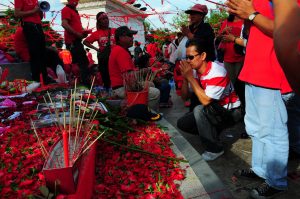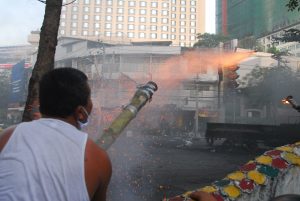Memo #60
Nelson Rand – nelsonrand [at] hotmail.com
 March 12, 2011 will mark the first anniversary of Thailand’s red-shirt protesters’ massive street campaign in Bangkok that ended in some of the worst political violence in modern Thai history. 91 people were killed and over 1,800 were injured in a military crackdown that resembled more of a civil war than a restoration of order. This was mainly due to the appearance of mysterious black-clad men on the side of the protesters who engaged the Thai army with automatic rifles and grenade launchers.
March 12, 2011 will mark the first anniversary of Thailand’s red-shirt protesters’ massive street campaign in Bangkok that ended in some of the worst political violence in modern Thai history. 91 people were killed and over 1,800 were injured in a military crackdown that resembled more of a civil war than a restoration of order. This was mainly due to the appearance of mysterious black-clad men on the side of the protesters who engaged the Thai army with automatic rifles and grenade launchers.
One year later, little has changed. The country remains a political and social tinderbox. A mysterious bombing campaign in Bangkok and upcountry after the crackdown suddenly stopped in November. But its abrupt end hints that the perpetrators were not just acting on their own but belonged to a movement that had a command structure. The worry is that if such a movement exists, a violent campaign could be turned back on at any time.
Meanwhile, peaceful protests continue. The red-shirts, formally called the United Front for Democracy Against Dictatorship (UDD), regularly musters about 20,000 supporters for daylong protests in Bangkok. They have just scored a small victory as 7 of their jailed leaders were granted bail on February 22. The release of leaders had been the group’s main short-term objective and rallying call over the past several months. Although many more of their leaders remain in hiding, mostly in neighbouring Cambodia. The UDD’s main long-term goal is to see a fundamental change in Thai society. They would like to end the domination of power by the country’s elite and see the empowerment of the underclass.
The UDD is first and foremost a social movement. It is not – and never has been – a cohesive group. It is a broad movement consisting of a collection of groups that share similar goals but may differ on the strategy to take to achieve those goals. While most of these groups and their supporters favour peaceful measures, some of them believe that a violent struggle is the only way to succeed, as peaceful measures have failed so far.
Thailand’s crisis is far from over and its deadliest phase may be yet to come.
About the Author:
Nelson Rand is a Canadian journalist based in Bangkok who has been covering insurgencies and political protests in Thailand for the past 6 years
Related Memos:
- Video Interview: Nelson Rand, a Canadian journalist wounded in Bangkok analyzes the Thailand conflict (Memo #14)
- What’s Next for Thailand? A Post-Crackdown Commentary (Memo #8 by Aim Sinpeng)
- Threads, Robes, and Alms-Rounds: Thai Buddhist Monks in the Recent Yellow Shirt vs. Red Shirt Conflict (Memo #5 by Jessica Main)
- Thai Academics Are As Polarized And Dispirited As Their Nation (Memo #1 by Paul Evans)
- Our other Memos about Thailand
- Our collection of Memos on the Thailand 2011 Election and 2010 Conflict
- See Nelson Rand’s related Memos: Nelson Rand, a Canadian journalist wounded in Bangkok analyzes the Thailand conflict (Memo#14), Thai-Cambodian Border Clashes – What is Fuelling them? (Memo#80) Dramatic Reforms in Burma (Video Interview with Nelson Rand) (Memo#113)

